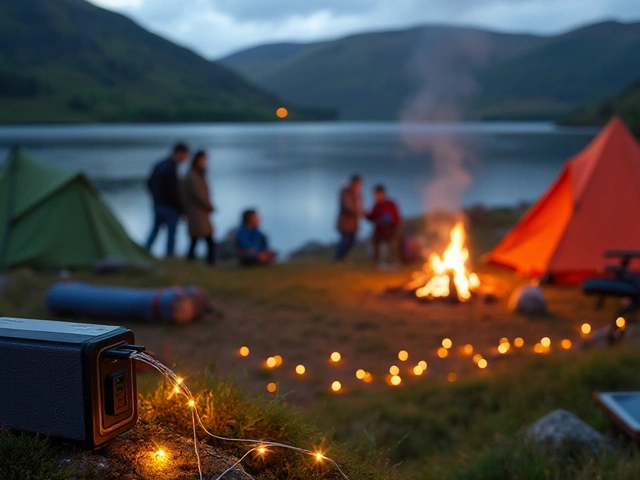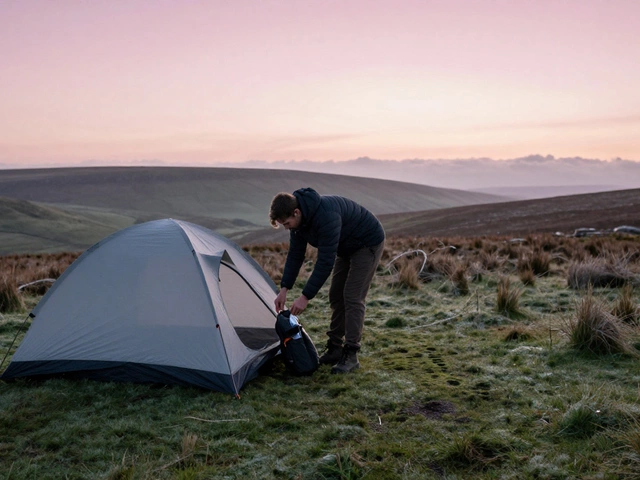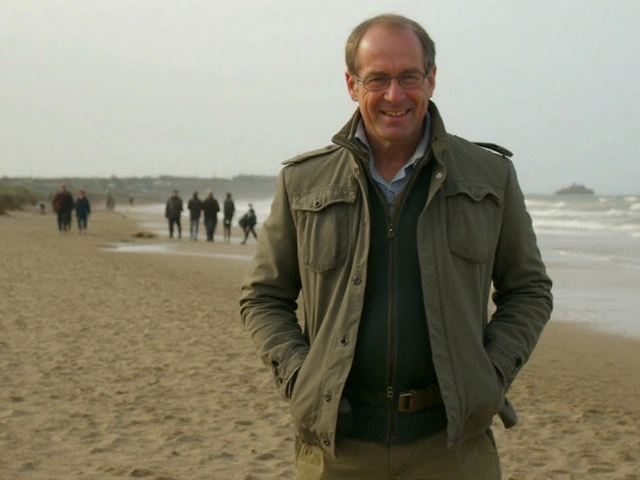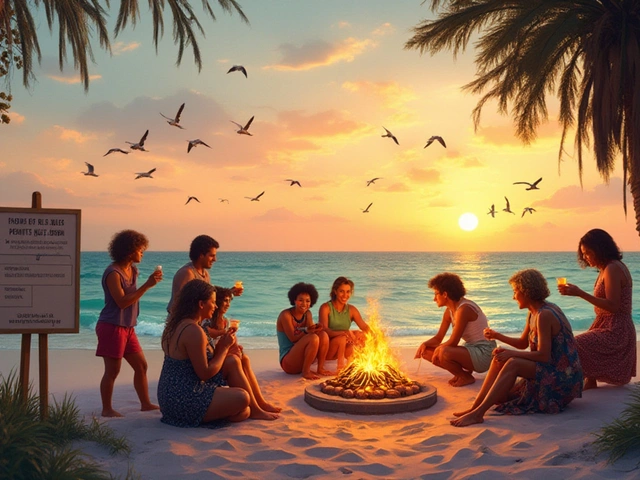Think you can just pitch a tent anywhere in Michigan’s wild forests? Well, it’s not quite that simple, but there’s a lot more freedom than you might expect. Michigan has over 4 million acres of public land, and most of it is open to camping if you follow a few straightforward rules.
The tricky part is knowing which land is open, what’s off-limits, and what local rules apply. If you head into a state forest, you’re usually good to go with some basic guidelines. Federal land works a bit differently, but you have options there too. If you’re looking to get away from crowded campgrounds and noisy neighbors, dispersed camping—where you set up outside of developed areas—might be exactly what you want.
Before you toss your gear in the truck and hit the road, take a minute to learn about where you can stay, which permits you might need, how to avoid the most common mistakes, and a few tips that’ll make your time on public land a whole lot better.
- Where You Can Camp: State vs. Federal Land
- Dispersed Camping: What It Means in Michigan
- Rules, Permits, and Length of Stay
- Finding a Great Campsite
- Campfires, Trash, and Wildlife: Staying Safe and Legal
- Tips for a Great Michigan Public Land Campout
Where You Can Camp: State vs. Federal Land
When it comes to camping on public land in Michigan, you’ve got two main choices: state-owned land and federally managed land. Each has slightly different rules, and it's pretty important to know the differences if you want to avoid a hefty fine or a confused park ranger showing up at your tent.
Michigan’s state forests cover almost 4 million acres and are run by the Department of Natural Resources (DNR). Most of these state forest lands are open for dispersed camping, which just means setting up camp away from established campgrounds. All you need in these areas is a "camp registration card"—basically, a free permit that you fill out and post at your site. You can camp almost anywhere except within one mile of a designated state forest campground or where signs say otherwise.
National forests are the big federal spots: Huron-Manistee, Ottawa, and Hiawatha. Combined, they offer about 2.8 million acres for camping. Dispersed camping is allowed here too, but you need to know the boundaries and stick to federal rules. Certain places, like recreation areas or near lakes, might not allow random camping or could have extra rules about campfires and length of stay. Bottom line? Always double-check before you claim your spot.
| Land Type | Managing Agency | Approximate Acres | Dispersed Camping Allowed? |
|---|---|---|---|
| State Forest | Michigan DNR | 3.9 million | Yes (with free card) |
| National Forest (Huron-Manistee, Ottawa, Hiawatha) | US Forest Service | 2.8 million | Yes (some areas restricted) |
| State Parks, Recreation Areas | Michigan DNR | 360,000+ | No (use developed sites) |
Don’t mistake state parks for state forests. State parks and recreation areas want you to camp only in designated campgrounds—no setting up in the middle of the woods there. If you’re after true backcountry camping, stick with state and national forests for the best experience.
The camping options in Michigan really add up once you get a handle on what kind of public land you’re looking at. Bring a map, double-check online if you’re not sure, and don’t just go by what someone said on a forum last year.
Dispersed Camping: What It Means in Michigan
Let’s break down what dispersed camping actually is in Michigan. Basically, it means camping outside of designated campgrounds—no picnic tables, no bathrooms, just you, your shelter, and nature. Michigan lets you do this on most state forest land and national forests, as long as you follow the basic rules. You won’t find marked sites or pay a nightly fee. It’s camping in its simplest form.
On state forest land, here’s how it works: Pick a spot at least one mile away from any official campground. Stay off private property and keep at least 200 feet from water to protect lake and riverbanks. You have to fill out a free registration card and post it at your site—these are self-serve and found online or at state forest kiosks.
- Pick a site that’s already been used if possible, to limit your impact.
- Stay only up to 15 days in one spot, then move at least five miles if you want to keep camping.
- No reserved spots; first come, first served.
In Michigan’s national forests (like Huron-Manistee, Ottawa, or Hiawatha), rules are similar but can have small differences. You’ll still need to be away from developed sites and respect distance rules from water and trails. Some areas may have fire bans during dry spells.
Here’s a quick comparison of key rules for dispersed camping in state and federal lands:
| Area | Permit/Card Needed? | Max Stay | Distance from Campgrounds | Campfire Allowed? |
|---|---|---|---|---|
| Michigan State Forest | Yes, free registration card | 15 days | 1 mile | Usually, unless there’s a fire ban |
| National Forest | No unless posted | 14 days | Varies, usually at least 100 ft | Usually, unless there’s a fire ban |
If you only remember one thing, make it this: always check for current local rules and restrictions before heading out, because stuff like wildfire risk or new closures can change things fast. Dispersed camping gives you freedom, but it also means you have to be responsible for everything—water, trash, and your safety. If you leave your spot better than you found it, you’re doing it right.
Rules, Permits, and Length of Stay
If you’re eyeing a forest campsite on public land in Michigan, you’ll want to nail down the rules before you set out. The good news? Michigan is actually known for having fairly relaxed rules compared to other states. But there are still some things you can’t skip or ignore.
First off, on state forest land, you’re free to camp pretty much anywhere that’s not posted “no camping,” but you must fill out a free camp registration card from the Michigan Department of Natural Resources (DNR). You snag one at the nearest DNR office, print it online, or just write it out. Stick one half of the card on your tent or post it at your site, and drop the other half in a drop box or return it to the DNR later. No cash, no fuss.
On federal land like Huron-Manistee National Forest, you don’t need a state registration tag, but you do need to follow their rules, which can be a bit different. Most spots let you camp for free, but always check the nearest forest office’s website since some areas have special permits or fire restrictions.
“Registration cards help us track usage, make better decisions for hunters and campers, and protect the forests for everyone.” — Michigan Department of Natural Resources spokesperson, 2024
How long can you actually stay? Michigan state forests let individuals or groups camp in the same spot for up to 15 consecutive nights. After that, you need to move at least one mile away if you want to keep camping. In national forests, the rule is usually 14 days, but a few areas ask you to move sooner. If you try to stretch your stay past the limit, rangers may stop by and ask you to pack up.
| Type of Land | Permit Needed? | Max Stay | Notes |
|---|---|---|---|
| Michigan State Forest | Free camp registration card | 15 nights | Post card at your site |
| National Forest (like Huron-Manistee) | Often none | 14 days | Some sites require area-specific permits |
| State Parks | Reservation, vehicle permit | Varies | Only at campgrounds, not for dispersed camping |
Here’s a simple checklist for camping legally on public land in Michigan:
- Double-check who manages the land (state, federal, or local).
- Get and display your registration card or any required permit.
- Know how long you’re allowed to stay in each spot.
- If you’re unsure, call or check the official website for that forest or park.
Stay within the rules, display your permit, and you’ll avoid the hassle of getting booted by a park ranger. It might take a minute to get set up, but it’s worth it if you want to enjoy public land and keep access open for others.
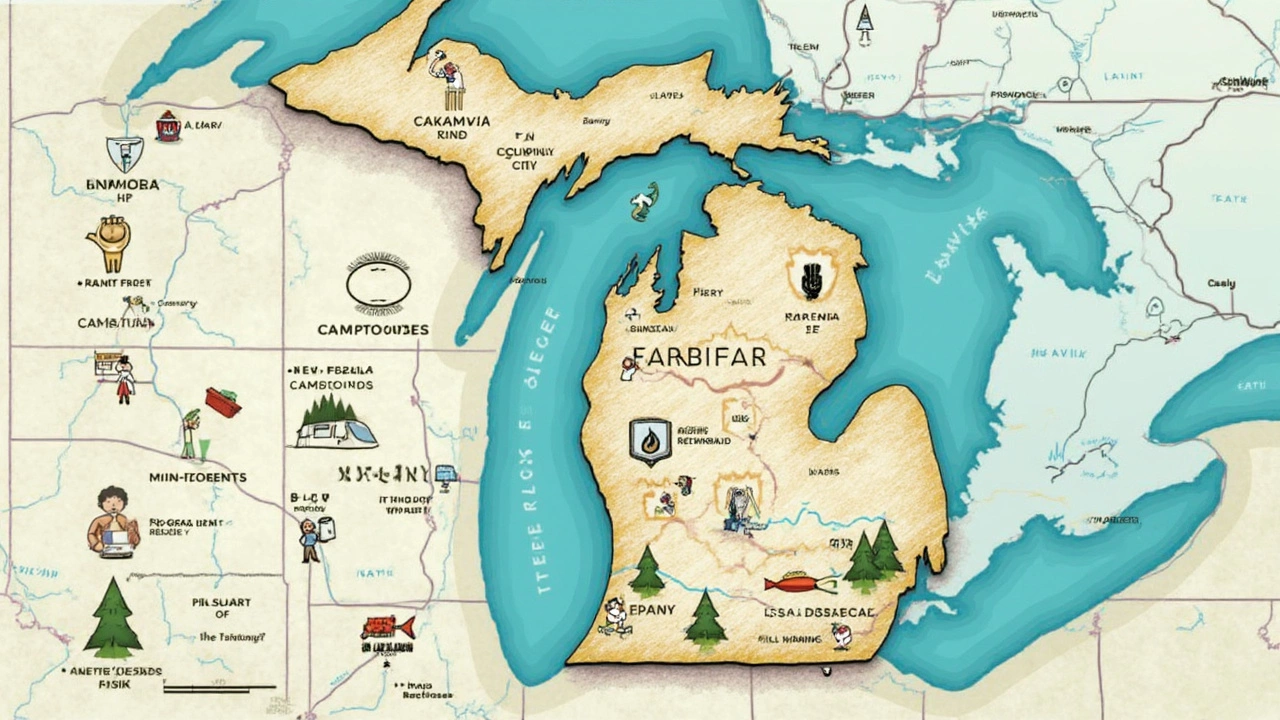
Finding a Great Campsite
So, you’re heading out to camp on public land in Michigan—where exactly do you stake your claim? Whether you’re deep in state forest or wandering a national forest, the best campsites usually come down to location, accessibility, and a bit of local know-how.
Start with a good map. Michigan DNR’s online state forest maps and the U.S. Forest Service interactive maps show which areas allow primitive camping. Don’t pick spots marked “no camping,” like trailheads, boat launches, or within 200 feet of water (unless otherwise posted). The sweet spot is usually a little ways off a forest road, as long as you’re not blocking any paths or bothering wildlife.
If you want the real deal—peace, pretty woods, and room to explore—follow these basic tips:
- Choose a flat spot (high ground if rain is in the forecast).
- Stay at least 200 feet from lakes, streams, and rivers, unless there’s a marked site right by the water.
- Look for signs of previous use (fire rings, cleared areas) to minimize your own impact.
- Don’t camp in the middle of trails, roads, or ATV routes.
- Check for dead trees (“widowmakers”) that could fall on your tent.
Some of the most popular forest areas for camping in Michigan include the Huron-Manistee National Forest, Ottawa National Forest, and big stretches of state forest like Pigeon River Country. National forests have tons of hidden spots that aren’t on standard campground lists—just make sure you follow local rules and stay within the maximum number of days (usually 14 days in one spot).
If you’re wondering about how crowded it might get, here’s a handy look at campsite pressure based on public data for peak weekends in 2024:
| Forest Area | Average People Per Square Mile (Peak Weekend) | Chances of Finding a Spot |
|---|---|---|
| Huron-Manistee National Forest | 3.1 | High |
| Ottawa National Forest | 1.7 | Very High |
| Pigeon River Country State Forest | 2.6 | High |
| Lake Superior State Forest | 0.8 | Excellent |
If you’re looking for even more solitude, keep driving or hiking a few miles past the first pull-offs near main roads. Cell service usually fades, but so do the crowds. Just remember to let someone know where you’re going, especially in the thick woods up north.
One last thing—a lot of folks miss this—grab a free camp registration card at state forest kiosks or online. Stick it on your dashboard or tent to avoid a surprise visit from conservation officers. That tiny extra step is a lifesaver, especially during busy times like Memorial Day or the Fourth of July.
Campfires, Trash, and Wildlife: Staying Safe and Legal
Sitting around the fire is a huge part of the camping experience in Michigan, but there are a few ground rules. If you’re camping in one of Michigan’s state forests or on federal land, you can have a campfire as long as there isn’t a fire ban. Always check fire danger levels online before you light up—even a small fire can get out of hand if conditions are dry. Big wildfires sometimes start from campfires that weren’t fully put out, so use water and stir the ashes until they’re cool to the touch before leaving or going to bed.
Treat trash like it’s your worst enemy. Michigan public lands operate under the “Pack It In, Pack It Out” rule. That means whatever you bring, you take back out. Don’t leave food scraps, cans, or wrappers—animals will find them, and it’s not just raccoons you need to worry about. Black bears have a serious sweet tooth and a great nose. If you’re camping in the Upper Peninsula or the northern Lower Peninsula, food storage is a must. Hang your food or use a bear-proof container.
Take a look at this breakdown of common wildlife encounters on Michigan public land:
| Animal | Region Seen | Best Practice |
|---|---|---|
| Black Bears | Mostly North Michigan, Upper Peninsula | Store food out of reach, use bear-proof canisters |
| Raccoons | Statewide | Secure all food and trash overnight |
| Deer | Statewide | Don’t feed; keep distance |
| Ticks | Wooded/brushy areas | Wear long sleeves, check for ticks daily |
If you use soap or toothpaste, keep it at least 200 feet from streams or lakes. Most soaps are bad news for the fish and water bugs. Michigan law also says you can’t dump greywater (dish or washing water) in lakes or rivers, so scatter it on dry ground away from water sources.
- Never burn trash or leftover food in your fire—it smells bad, looks worse, and can mess up the local environment.
- If you’re unsure about something, ask a local ranger or look online for the latest updates on fire safety and wildlife alerts.
- Always pack out used toilet paper and hygiene products if there aren’t vault toilets nearby.
Keeping Michigan’s wild spaces clean and safe is everyone’s job. Follow the rules and you’ll help keep these spots awesome for future trips—not just for you, but for everyone else, too.
Tips for a Great Michigan Public Land Campout
Getting the most out of your time camping on public land in Michigan isn’t rocket science, but a few tricks can save you headaches and make your trip safer. Here’s what experienced locals do before heading out:
- Check the rules for your exact spot. Don’t assume every patch of public land has the same rules. State forests let you camp almost anywhere if you’re more than a mile from a designated campground, but national forest spots might have different restrictions. The Michigan DNR website has up-to-date info, and a quick phone call to a ranger station can clear up anything weird.
- Print (or save) the permit. In state forests, you need a free camp registration card. It’s simple—you fill it out and post it at your campsite. Some folks just take a photo with their phone in case the wind carries it off. Don’t skip this; it’s checked more often than you’d think.
- Pick your campsite carefully. Avoid low spots that turn messy when it rains. Look for flat ground, but not too close to rivers and lakes—Michigan’s 200-foot rule from the water is real, and you don’t want a surprise fine.
- Pack out all your trash. There are no dumpsters or trash cans away from established campgrounds. Squirrels and raccoons will drag out anything you leave behind, and Michigan’s rangers take clean-up rules seriously.
- Use a small stove if you can. Campfires are great, but Michigan has burn bans during dry spells, especially in late summer. A simple backpacking stove keeps you fed whether fire’s allowed or not, and it leaves no trace.
- Prepare for bugs—seriously. Black flies and mosquitoes can be relentless, especially in May and June. Bring good bug spray and consider a head net. Long sleeves help, too, even when it’s warm out.
- Keep it quiet and low-key. Public land is shared space. Noise travels in the woods, and locals aren’t shy about reporting trouble. Most folks just want peace and a clean place to camp—don’t stand out for the wrong reasons.
- Always let someone know where you’re going. Cell service is hit or miss on Michigan’s public land, especially in the Upper Peninsula. Even just texting a buddy with your general area is smart.
One last thing: If you find a great spot, use a free mapping app like OnX Hunt or the Michigan DNR’s own map tool to mark it. Spots that are legal, dry, and beautiful can be hard to find, so keep a record for next time. With these tips, your camping trip on Michigan’s public land is way more likely to be a win.


